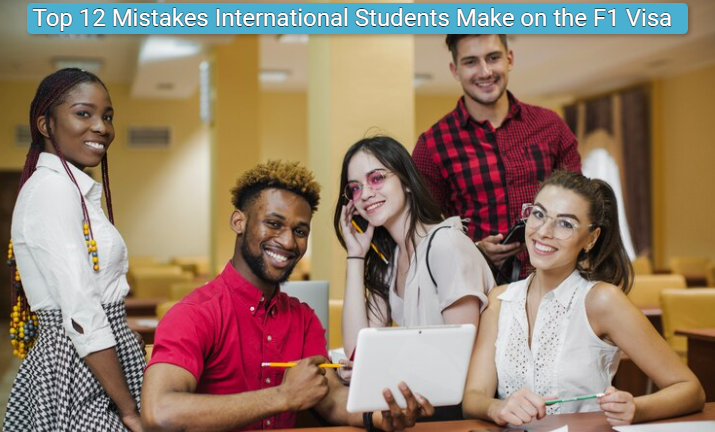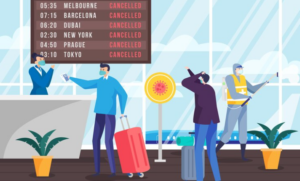Top 12 Mistakes International Students Make on the F1 Visa

The F1 visa student experience can lead to a world-class education in the United States—but it is also subject to strict procedures and rules. Every year, numerous applicants are rejected or have their status violated simply because they didn’t know what to avoid.
Whether you’re coming from overseas or are already in the U.S., knowing the most frequent blunders will save your visa, reduce unnecessary anxiety, and keep you on top of your schoolwork and your legality. Below are the top 12 errors that international students typically make on the American F1 visa, and how to avoid them.
1. Incomplete or Incorrect Visa Documents
Submitting incorrect or inconsistent documents during the visa student application process is one of the most common mistakes. Small discrepancies in your DS-160, passport, I-20, or financial documents can lead to delays or even denial.
The visa document requirements include a valid passport, Form I-20, proof of financial support, and SEVIS fee payment confirmation. Ensure everything aligns—especially your SEVIS ID, bank statements, and academic credentials—to avoid unnecessary scrutiny.
2. Poor Interview Preparation and Miscommunication

The F1 visa interview is not just a formality. It’s a major part of your application. If you look lost or provide unclear responses regarding your university, course, or funding, the officer might suspect you of having other intentions.
Keep in mind that an F1 visa student is a non-immigrant visa, so you need to demonstrate that you are going back home after graduation. Inconsistent answers or displays of immigrant intention are also among the key contributors to the US visa rejection rate.
3. Poor or Unclear Financial Sponsorship
Not being able to demonstrate how you will fund your education is a common reason for rejection. Your f1 student visa sponsorship should demonstrate that funds are available, adequate, and in line with your I-20.
Students usually inquire whether sponsoring F1 visa is possible through distant relatives or family friends. Technically yes, but you have to present solid evidence such as notarized affidavits, bank letters, and income tax returns. Weak or unverifiable documents usually result in rejection.
4. Applying at the Wrong Time or From the Wrong Location
Most students ask themselves, Do I have the opportunity to apply for a student visa while already in the US? The response is yes, as long as you’re doing status change legally and filing within allowed timeframes. For instance, if you are changing from B2 to F1, you should not initiate studies until approval of the status change by USCIS.
Likewise, if you apply from a third nation where you are not a long-term resident, it might be delayed or rerouted to your home consulate. These are simple mistakes to avoid that can complicate your study abroad visa process.
5. Wrong Program or Institution
Your educational plan needs to be logical to the consular officer. Choosing a course out of the context of your past work or an institution that is not accredited can invite skepticism.
As only SEVP-approved schools are eligible for the foreign student visa, your course should also align with your long-term objectives. For instance, seeking a 1-year diploma and asking for a 5-year student visa USA might be questioned unless justified.
6. Breaking F1 Visa Rules After Arrival

After entering the U.S., the biggest risk is thinking you’re out of danger regarding visa problems. Offenses such as working illegally, falling below full-time enrollment, or missing classes can lead to automatic SEVIS cancellation.
If you’re on OPT and encounter a problem like F1 visa renewal on OPT rejected, it’s usually because of previous offenses or missing papers. Never work off-campus without permission, and always report significant changes to your DSO.
7. Disregarding SEVIS Obligations and DSO Instructions
Too many students forget that their SEVIS record is an active federal database. Even small updates—such as updating your address—need to be reported to your Designated School Official (DSO) within 10 days.
Incomplete SEVIS updates can lead to record deactivation. When you’re making the switch from F2 to F1, make sure you use the proper F2 visa documents checklist and inform your DSO of your change of status. This keeps you safe and in compliance.
8. Abusing CPT or OPT Authorization
Curricular Practical Training (CPT) and Optional Practical Training (OPT) provide rewarding work experience—but abusing them can invalidate your visa status.
The most common errors are:
- Beginning work without approval
- Working with an employer who is not approved
- Hours of weekly work, which are not observed
A lot of students abuse CPT in their initial semester or coincide CPT and OPT periods. Keep in mind: F1 is not an American student work visa, and work is allowed only under specially outlined rules.
9. Traveling Without Proper Authorization or Planning

Students frequently ask, How does F1 travel overseas operate? Traveling on an F1 visa should be well-planned. If you don’t have a valid stamp of the visa, I-20 travel signature (recently within 12 months), or active SEVIS record, you may get denied re-entry.
This is particularly dangerous during OPT. Traveling outside the United States without your EAD card or job opportunity can keep you from re-entry. Before making international travel plans, review all documents and with your DSO ensure that you’re clear to leave and come back safely.
10. Staying Too Long or Not Being Prepared After Graduation
On graduation, you receive a 60-day grace period. Most students delay action, overstay, or don’t apply for OPT promptly—resulting in illegal presence or visa issues.
If you intend to work in the U.S., you need to migrate smoothly to an H1B or other visa status. Any errors here may impact your long-term immigration future. Always go through your DSO, or an immigration expert, to finalize proper procedures on completion of your program.
These errors also pertain to larger issues such as abroad student visa quotas, foreign student requirements, and qualification for transitions under types of visas for students.
11. Submitting Without Knowing Visa Timelines and Processing Delays
Most students submit too late, unaware that visa interview appointments, administrative processing, or USCIS status change approvals can take weeks—or even months. Late submissions may compel students to postpone their admission or miss orientation.
You need to account for embassy delays, document checks, and the I-20 processing time. If you are already in the U.S. and intend to change your status, always check how long USCIS takes for a visa student application or F1 approval.
Not planning can lead to rushing, missed documents, or even denial due to lack of preparation time.
12. Not Understanding the Long-term Impact of a Visa Denial

One denial of your study abroad visa or foreign student visa does not make you forever ineligible—but it does remain in your immigration record. Students who get an F1 visa renewal on OPT rejected notice or denial need to know how it can impact future visa types such as H1B or B1/B2.
Every rejection is logged in the U.S. immigration database, and therefore even subsequent applications under types of visas for students or work visas can invite further scrutiny. Always fix the root cause of rejection and address it before reapplying.
Don’t Risk Your F1 Visa—Get Expert Help Today
Having trouble with your F1 visa or experiencing issues with OPT, SEVIS, or visa renewal? Our skilled immigration lawyers at Passage Immigration Law are here to help you every step of the way.
Schedule a consultation today and safeguard your future in the U.S.
